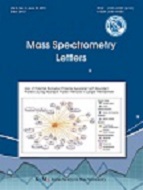
- P-ISSN 2233-4203
- E-ISSN 2093-8950



In this study, we present a new isotope-coded carbamidomethylation (iCCM)-based quantitative proteomics, as acomplementary strategy for conventional isotope labeling strategies, with providing the simplicity, ease of use, and robustness. In iCCM-based quantification, two proteome samples can be separately isotope-labeled by means of covalently reaction of allcysteinyl residues in proteins with iodoacetamide (IAA) and its isotope (IAA-13C2, D2), denoted as CM and iCCM, respectively,leading to a mass shift of all cysteinyl residues to be + 4 Da. To evaluate iCCM-based isotope labeling in proteomic quantification,6 protein standards (i.e., bovine serum albumin, serotransferrin, lysozyme, beta-lactoglobulin, beta-galactosidase, andalpha-lactalbumin) isotopically labeled with IAA and its isotope, mixed equally, and followed by proteolytic digestion. Theresulting CM-/iCCM-labeled peptide mixtures were analyzed using a nLC-ESI-FT orbitrap-MS/MS. From our experimentalresults, we found that the efficiency of iCCM-based quantification is more superior to that of mTRAQ, as a conventional nonisobariclabeling method, in which both of a number of identified peptides from 6 protein standards and the less quantitative variationsin the relative abundance ratios of heavy-/light-labeled corresponding peptide pairs. Finally, we applied the developediCCM-based quantitative method to lung cancer serum proteome in order to evaluate the potential in biomarker discovery study
Wolters, D. A.. (2001). . Anal. Chem, 73, 5683-.
Aebersold, R.. (2003). . Nature, 422, 198-.
Schiess, R.. (2009). . Molecular Oncology, 3, 33-.
Asara, J, M.. (2008). . Proteomics, 8, 994-.
Ong, S. E.. (2002). . Mol. Cell. Proteomics, 1, 76-.
Gygi, S. P.. (1999). . Nature Biotechnology, 17, 994-.
Thompson, A.. (2003). . Anal. Chem, 75, 1895-.
Ye, X.. (2009). . Briefings in Functional Genomics & Proteomics, 8, 136-.
Kang, U. B.. (2010). . J. Proteome Res, 9, 3750-.
Kim, J. Y.. (2012). . Anal. Chem, 84, 5343-.
Duché, J. C.. (2000). . Clin Biochem, 33, 197-.
Pallis, A. G.. (2010). . Ann. Oncol, 21, 692-.
Heo, S. H.. (2007). . Proteomics, 7, 4292-.
Wang, C. L.. (2009). . J. Proteome Res, 8, 4428-.
Zeng, X.. (2010). . J. Proteome Res, 9, 6440-.
Tyan, Y. C.. (2005). P. C. J. Proteome Res. 2005. J. Proteome Res, 4, 1274-.
Dowling, P.. (2007). . Electrophoresis, 28, 4302-.
Ahn, Y. H.. (2012). . J. Proteomics, 75, 5507-.